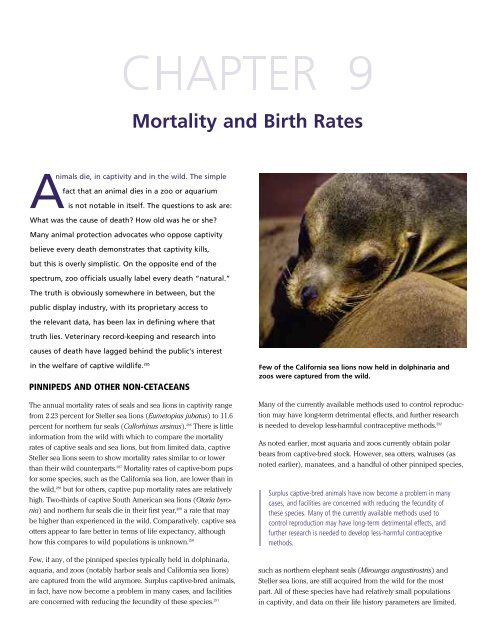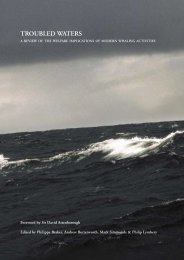The Case against Marine Mammals in Captivity - The Humane ...
The Case against Marine Mammals in Captivity - The Humane ...
The Case against Marine Mammals in Captivity - The Humane ...
- No tags were found...
You also want an ePaper? Increase the reach of your titles
YUMPU automatically turns print PDFs into web optimized ePapers that Google loves.
Mortality and Birth RatesAnimals die, <strong>in</strong> captivity and <strong>in</strong> the wild. <strong>The</strong> simplefact that an animal dies <strong>in</strong> a zoo or aquariumis not notable <strong>in</strong> itself. <strong>The</strong> questions to ask are:What was the cause of death? How old was he or she?Many animal protection advocates who oppose captivitybelieve every death demonstrates that captivity kills,but this is overly simplistic. On the opposite end of thespectrum, zoo officials usually label every death “natural.”<strong>The</strong> truth is obviously somewhere <strong>in</strong> between, but thepublic display <strong>in</strong>dustry, with its proprietary access tothe relevant data, has been lax <strong>in</strong> def<strong>in</strong><strong>in</strong>g where thattruth lies. Veter<strong>in</strong>ary record-keep<strong>in</strong>g and research <strong>in</strong>tocauses of death have lagged beh<strong>in</strong>d the public’s <strong>in</strong>terest<strong>in</strong> the welfare of captive wildlife. 285PINNIPEDS AND OTHER NON-CETACEANS<strong>The</strong> annual mortality rates of seals and sea lions <strong>in</strong> captivity rangefrom 2.23 percent for Steller sea lions (Eumetopias jubatus) to 11.6percent for northern fur seals (Callorh<strong>in</strong>us urs<strong>in</strong>us). 286 <strong>The</strong>re is little<strong>in</strong>formation from the wild with which to compare the mortalityrates of captive seals and sea lions, but from limited data, captiveSteller sea lions seem to show mortality rates similar to or lowerthan their wild counterparts. 287 Mortality rates of captive-born pupsfor some species, such as the California sea lion, are lower than <strong>in</strong>the wild, 288 but for others, captive pup mortality rates are relativelyhigh. Two-thirds of captive South American sea lions (Otaria byronia)and northern fur seals die <strong>in</strong> their first year, 289 a rate that maybe higher than experienced <strong>in</strong> the wild. Comparatively, captive seaotters appear to fare better <strong>in</strong> terms of life expectancy, althoughhow this compares to wild populations is unknown. 290Few, if any, of the p<strong>in</strong>niped species typically held <strong>in</strong> dolph<strong>in</strong>aria,aquaria, and zoos (notably harbor seals and California sea lions)are captured from the wild anymore. Surplus captive-bred animals,<strong>in</strong> fact, have now become a problem <strong>in</strong> many cases, and facilitiesare concerned with reduc<strong>in</strong>g the fecundity of these species. 291Few of the California sea lions now held <strong>in</strong> dolph<strong>in</strong>aria andzoos were captured from the wild.Many of the currently available methods used to control reproductionmay have long-term detrimental effects, and further researchis needed to develop less-harmful contraceptive methods. 292As noted earlier, most aquaria and zoos currently obta<strong>in</strong> polarbears from captive-bred stock. However, sea otters, walruses (asnoted earlier), manatees, and a handful of other p<strong>in</strong>niped species,Surplus captive-bred animals have now become a problem <strong>in</strong> manycases, and facilities are concerned with reduc<strong>in</strong>g the fecundity ofthese species. Many of the currently available methods used tocontrol reproduction may have long-term detrimental effects, andfurther research is needed to develop less-harmful contraceptivemethods.such as northern elephant seals (Mirounga angustirostris) andSteller sea lions, are still acquired from the wild for the mostpart. All of these species have had relatively small populations<strong>in</strong> captivity, and data on their life history parameters are limited.
















